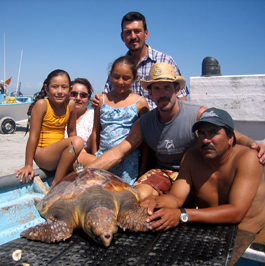home | metro santa cruz index | news | santa cruz | news article

One Big Happy Family: UCSC doctoral candidate Hoyt Peckham, in hat, is pictured with two fishermen of Punta Abreojos in Baja California and their families preparing to release a loggerhead turtle with satellite transmitter.
Loggerhead Turtles in Trouble
A groundbreaking study by UCSC researchers finds that small-scale fisheries are the bane—and the salvation—of endangered loggerhead turtles.
By Traci Hukill
The picture is hideous and unspeakably sad: a half-dozen desiccated loggerhead turtle carcasses on the Baja beach in various agonized postures. The cause of death is drowning; these turtles were by-catch, unintentionally snared by nets or fishing lines set along the sea floor and tossed ashore after being hauled up with the catch.
The photographer is Hoyt Peckham, a doctoral candidate in ecology and evolutionary biology at UCSC who spent much of the last six years in Baja California studying the reason for the North Pacific loggerhead's plummeting numbers. The results of the study Peckham co-authored with a handful of other researchers, to be published online today in the open-access journal PloS ONE, are stunning: small-scale fisheries operated out of skiffs straight out of The Old Man and the Sea are accidentally killing as many loggerheads as industrial long-line fishing fleets in the North Pacific. In fact, on a per-hook or per-net basis, the low-tech, hand-operated fishing fleets are up to 1,000 times deadlier to the turtles than your average factory trawler.
"When I thought of by-catch, I always thought of huge factory ships pillaging the open ocean," says Peckham, who is back in Santa Cruz for the fall to write his dissertation. "I grew up around open boats, and you never think a couple of guys hauling up fish with simple gear could have that much impact."
One problem, explains study co-author Wallace J. Nichols, an Ocean Conservancy senior scientist who lives in Davenport, is that small-scale fishermen tend to drop bottom-set lines and bottom-set gill-nets and then leave. When they return a couple of days later, any ensnared turtles have already drowned. Some trawlers, by contrast, "are pulling the nets up to the deck in a couple of hours," he says, "so sometimes the turtles are still alive, though they can be in pretty bad shape."
If there's a species that can't afford to lose any more ground, it's the North Pacific loggerhead. In the last three generations, the nesting population in Japan has dropped 50 percent to 90 percent, for a total of fewer than 1,500 nesting North Pacific females. The loggerheads in the study are generally juveniles who travel to Mexico to feed and spend a three-decade-long "adolescence" before reaching reproductive maturity. The slow maturity rate leaves the species so vulnerable that the U.S. National Marine Fisheries Service has estimated that the loss of 37 to 92 large juveniles per year would "appreciably" increase the animal's risk of extinction. Peckham, Nichols and other researchers estimate that, at a minimum, the two small Mexican fleets they studied were accidentally killing 1,000 turtles per year.
But if there's one thing Peckham doesn't want, it's for the study to come across as a criticism of the world's small-scale fishermen, who account for 99 percent of the world's 51 million fisherfolk. Although the Mexican fishermen didn't believe at first that loggerheads could possibly be endangered—"They'd say, what do you mean? I just caught 30 today!" Peckham says—they were eventually convinced. What happened next is a study in reasons to be hopeful about human nature and the fate of the planet.
Peckham, Nichols and their fellow researchers actively engaged the fishermen in the counting and tagging process, soliciting their expertise and hiring their kids as interns. Since Baja fishermen read a lot more comics than websites, they skipped the Netroots and printed up conservation-themed comic books. They filmed the fishermen engaged in conservation activities, whipped up short movies on their laptops and showed them in the villages.
It worked incredibly well. Many fishermen were galvanized to action; one fishing fleet declared a part of its territory a loggerhead reserve, partly with an eye toward eco-tourism. Just weeks ago, the patron of a fleet announced that he would be retiring his most destructive gear, the bottom-set long line with its hundreds of hooks. Instead he'll use surface-set gill-nets that will allow any turtles accidentally caught to come to the surface for air. His decision alone could save 700 turtles a year.
And that's how the turtle by-catch issue will be resolved, say Nichols and Peckham: one individual at a time. Since so much of the problem is with unregulated small-scale fisheries in developing nations, the solution can't be to just make new laws; there would be no one to enforce them.
"The policy action that is workable is to work on the local level to find real, humane, creative solutions to this by-catch issue," says Nichols. "That's not something you can do from the capitol, whether Washington, D.C., or Mexico City. It's definitely much more complicated, much less centralized and much more face-to-face."
This week, Nichols is in Washington, D.C., lobbying Congress for more money to spend on grassroots turtle conservation projects. He'll take one of the patron's retired hooks to every meeting. "It demonstrates physically what the gear is like, but also the possibility of transitioning to basically something more sane, if fishermen are approached the right way," Nichols says. "They don't want to destroy the ocean."
Send a letter to the editor about this story.
|
|
|
|
|
|